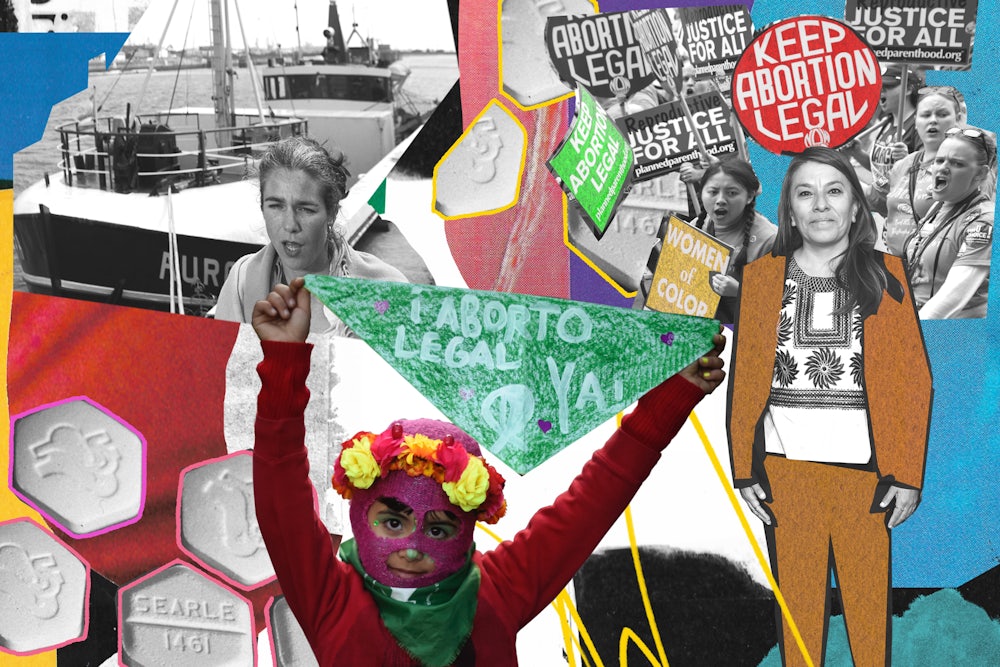On a rainy evening in June 2001, abortion pirates sailed into Dublin harbor. Their converted fishing trawler had a portable clinic bolted to the deck, and the cargo included 20 doses of medication abortion (mifepristone and misoprostol), thousands of condoms, 120 IUDs, and 250 morning-after pills. The ship’s nearly all-female crew included a nurse and a gynecologist and was led by Rebecca Gomperts, a freckled and dark-haired Dutch doctor in her mid-thirties. The boat made its way up the River Liffey and docked close to a waiting crowd of activists and journalists.
The ship was Gomperts’s brainchild. At the time, the World Health Organization estimated that 78,000 women died each year from unsafe abortions, many of them in countries where abortion was criminalized or inaccessible. Using maritime law, which holds that a ship in international waters is governed by the laws of its home port, Gomperts thought she could sail a vessel from her home in the Netherlands, where abortion was legal, and provide abortion care offshore from countries where it wasn’t. It was a provocative and daring thing to do—“abortion pirates” was what conservative opponents called them—but Gomperts, who had served as a doctor on a Greenpeace ship in the late 1990s, knew the publicity power of direct-action campaigns and believed it was well worth creating a stir over 78,000 women’s lives.

In Ireland, a last-minute bureaucratic hold prevented the ship from handing out pills, but the crew began to take calls from women needing abortions and directed them to clinics in England or the Netherlands. They invited the public on board and cheerily handed out contraceptives, condoms, and information on safe, self-managed medication abortion. Gomperts’s organization, Women on Waves, has since sailed an abortion ship to Poland, Portugal, Spain, Morocco, Guatemala, and Mexico, and traveled to Venezuela, Ecuador, Tanzania, Chile, and Pakistan, where they worked with local activists to launch safe abortion hotlines or conduct trainings on self-managed abortion. Women on Waves has also sent drones carrying abortion pills into Poland and Northern Ireland, and robots carrying abortion pills, controlled from Amsterdam, into Northern Ireland and Mexico. On their website, you can see pictures of bewildered police officers trying to figure out how to arrest a robot.
Though the hotlines were long-term projects, the drones and robots in particular weren’t set up as sustainable models for abortion access. Instead, they were stunts intended to send a message: Access to abortion can’t be stopped, and women could—and would—self-manage their abortions safely, law be damned. As Gomperts put it, the project was this: “How could we create a space where the only permission a woman needed was her own?”
If Women on Waves was about making headlines, they were only the most visible part of a transnational and multigenerational movement, sensitively documented in Rebecca Grant’s new book, Access: Inside the Abortion Underground and the Sixty-Year Battle for Reproductive Freedom. Based on a decade of work as a reporter, Grant offers an immensely readable and deeply researched history, equal parts enraging and moving. Access interweaves profiles of activists around the world with deftly narrated context on science, politics, and history. We move from antebellum New York to 1960s Chicago, from Mexico in the 2000s to pharmacies in India, from the internet to an “undisclosed location in the American South” just before and after the Supreme Court drastically changed the legal landscape with its decision in Dobbs.
The conversation about abortion politics in the United States often focuses on laws—on winning rights and taking them away—and on morals. Grant, adamantly, focuses on access: getting people the reproductive care they seek. As the activists she profiles believe, and as her book illustrates, to focus on access is to wholly transform the conversation about what abortion is: a decision a woman makes, a procedure a woman has, something women will always seek regardless of laws. This is no small feat in a country where the anti-abortion right has successfully weaponized terms like life and heartbeat and baby, and where mainstream abortion politics have been stuck in a defensive crouch of lobbying and debating “choice.” Reading Grant’s history raises the question: If Planned Parenthood had sent abortion boats down the Mississippi and into the Gulf of Mexico, working with local activists to build safe abortion hotlines in Texas, Florida, Louisiana, Alabama, would things look different today?
Abortion in the United States has moved between eras of criminalization and eras of legality, but at no point have women ever stopped needing them or having them. In this sense, women’s lives have always rendered any abortion bans or restrictions illegitimate. Another way to say this is, by virtue of being women, we have always lived outside the law.
Through the mid–nineteenth century, abortion until “quickening”—when the fetus is felt to move, usually during the second trimester—was common practice and legally permitted. This changed in 1847, with the founding of the American Medical Association, which sought to institutionalize medicine and put power in the hands of (male) doctors. Its members were particularly incensed about midwives, and it was in the 1850s that the movement to criminalize reproductive care, from contraception to pregnancy to abortion to birth, began. The AMA formally adopted an anti-abortion stance in 1859, and criminalization laws really began to enter the books in 1860.
Abortion then became illegal for a century, though of course abortions continued. American literature from the 1910s through the 1940s is full of characters having abortions or trying to have abortions. Women of means traveled to Mexico or were connected to local doctors who did “clean work,” as is Joan Didion’s fragile heroine in the 1970 novel Play It as It Lays. Women without means resorted to these more desperate methods, among others: douches of powdered kitchen mustard or glycerin; flooding the uterus with kerosene and vinegar; inserting into the cervix paintbrushes, knitting needles, cocktail stirrers, telephone wire, pencils, chopsticks, bicycle pumps, or gramophone needles.
Grant’s story begins in 1966, when three women known as “the Army of Three” begin challenging California’s abortion restrictions by handing out lists of reputable abortion providers on San Francisco sidewalks. Just a few years prior, a sophomore at the University of Chicago had used her civil rights movement connections to help a friend access an illegal abortion, and the calls kept coming. With fellow feminist activists, she started an abortion counseling service to connect women to safe providers. Security was of the utmost concern, and so the women chose the most generic name for themselves: the Jane Collective.
By 1972, the Janes had developed a sophisticated security protocol, a list of reputable doctors, taught themselves how to perform surgical abortions safely and dispense with doctors entirely, offered a sliding scale payment program to make abortion accessible to everyone who called, and provided around 11,000 abortions. In May of that year, a police operation raided their rented apartment, arresting seven Janes, who spent the time in their paddy wagons from apartment to station ripping up and eating the patient contact cards they carried on them.
Along with the women’s liberation movement, the story of abortion access snowballs from here. On the West Coast, a handful of feminist activists drew from ob-gyn research to develop a menstrual extraction device, known as the “Del-Em” (a tongue-in-cheek abbreviation for “dirty little machine,” which one doctor called it), which allowed women in early pregnancy to self-abort safely. Packing 200 specula, they hit the road on a Greyhound Bus tour, traveling to 23 cities and giving live demonstrations of how to use it. These second-wave feminists were intuitively reversing the legacy of the AMA that had criminalized abortion in the first place: They were taking abortion care out of the hands of doctors, politicians, and men—and putting it back in the hands of women. The laws followed. In 1973, Roe v. Wade ruled that the government could not interfere in private medical decisions, and abortion became a federal right.
One of the revelations of Grant’s book is that Roe is a sidenote, rather than, as with liberal rights–based stories of abortion, the central story. Rights only matter if they are enforced and only if people can exercise them freely: Roe made no provision for either. At the same time that abortion clinics began to pop up across the country, anti-abortion politicians sought to limit the law, eventually winning passage of the Hyde Amendment in 1977, which banned use of federal Medicaid funding for abortions. Women—especially poor women and women of color—began dying.
The restrictions kept coming, led by the ascension of the religious right into Ronald Reagan’s political coalition. After his election, violent incidents against clinics and clinic staff jumped by 450 percent. Clinic staff were sent death threats, clinics were blockaded, and abortion providers were shot and kidnapped by anti-abortion terrorists. In 1993, a clinic in Corpus Christi, Texas, was firebombed. Feminist protesters mobilized in cities targeted by the “antis” and kept clinics open, but the terrain of struggle had shifted in the United States. Beginning under Bill Clinton’s leadership, Democrats moderated their support, calling for abortion to be “safe, legal, and rare,” while major feminist organizations like Planned Parenthood and Emily’s List continued to put their substantial resources toward lobbying politicians.
Meanwhile, the anti-abortion right organized, town by town and state by state, to make abortion harder to access and harder to provide. Between 2011 and 2013, over 200 abortion restrictions were passed. In the United States, activists organized abortion funds to help local women pay to travel out of state, pay for procedures, and cover costs of childcare or lost wages. But the need was overwhelming: By 2014, 90 percent of counties in the United States had no abortion clinic.
In 1986, Brazil approved the drug misoprostol for the treatment of stomach ulcers. The drug, under the brand name Cytotec, was sold over the counter and carried the warning “Avoid taking while pregnant.” With this tip-off, women in Brazil began “creatively misusing” it to self-manage their own abortions. A box of Cytotec cost the equivalent of $5 to $6, while a surgical abortion in one of Brazil’s underground clinics cost $300 to $1,000. Word spread among women and sympathetic pharmacists that this method worked to end pregnancies, and, noticeably, women stopped dying from unsafe abortions in the poorer towns of northeast Brazil.
“This was groundbreaking,” Grant writes, and the development of medication abortion—the drugs misoprostol and mifepristone—is the watershed moment in the story she tells. Rather than hinging on finding safe and trustworthy abortion providers, medication abortion made it possible for women without specialized training to safely end their pregnancy on their own terms and in their own communities. All a woman needed was the pills, usage instructions, and a support system in case there were complications. And now, feminists had the internet.
A gynecologist attending an international conference brought this news back home to Mexico to share with local activists, most notably Las Libres, a feminist collective in the conservative state of Guanajuato that organized access to abortion care for rape survivors. As Las Libres founder Verónica Cruz Sánchez stood in the clinic watching the gynecologist provide medication abortions, she thought: There is no reason this needs to happen in a doctor’s office, or under a doctor’s supervision.
Medication abortion is a simple, common, and safe procedure, according to the World Health Organization and decades of data-driven research, but the experience lasts over several days, and can be painful, frightening, and lonely—especially for a woman trying to keep her abortion secret from a disapproving or abusive family member. Las Libres didn’t want anyone to be alone and, in order to combat shame or stigma, wanted each woman to be guided by someone who had also gone through the process. Often, women would come to the collective after the abortion in gratitude and ask, “What can I do to ensure another woman can have this freedom?” “That,” Cruz told Grant, “was the lightbulb moment.” Each woman would accompany the next woman, and on and on, creating a sisterhood of compassionate and judgment-free abortion care, a practice known as acompañamiento, or accompaniment. In 2009, Las Libres began seeding accompaniment collectives across Mexico.
In 2006, Gomperts helped launch Women on Web, an international safe abortion service that functioned like a kind of global hotline. Gomperts registered as a doctor in Austria, where medication could be prescribed without an in-person visit. Payments are processed by a feminist foundation in Amsterdam, and medication is shipped from pharmaceutical partners in India, the world’s home of generic medicine. Teams of volunteers log on each day from around the world to answer, read, and translate requests for abortion, and to stay in touch with each woman as she goes through the procedure.
Here’s what one interaction, quoted in Vessel, a documentary about Women on Waves and Women on Web, looks like:
MAY 27, 7:20PM
Dear Women on Web,
I retrieved the pills from the post in Nairobi yesterday–
I kissed the medicine when it fell into my hands.
I am in the hotel and have just taken the second medicine now…
MAY 27, 8:35PM
Dear Emma,
How are you doing now?
Has the process started?
MAY 27, 8:55PM
My stomach aches, really bad, it is really painful…
Is this normal?
MAY 27, 9:16PM
Cramping is normal, it means the misoprostol pushing the pregnancy out.
You can take Ibuprofen for the pain.
MAY 28, 12:17AM
This by far is the loneliest I have been.
I am not a monster,
I just cannot have the baby.
MAY 28, 12:29AM
Emma,
You are not a monster for wanting an abortion.
1 in 3 women worldwide will have an abortion in her lifetime and we are not monsters!
You are being so incredibly strong and even if you feel alone you are taking good care of yourself.
That is something to be very proud of.
MAY 28, 10:33AM
Good morning. It was a long 15 hours but I feel ok now. I will go for an ultrasound to confirm. I am overwhelmed by your kindness. I thought it would be some automated reply, and instead there was a real human being there, who wanted to help me.
May I know your name? Just to keep you in my prayers?
MAY 28, 11:30AM
Thank you for your kind words, Emma.
We cannot tell you the name of the woman who was with you as we are a collective and many of us have been working last night.
We are always here if you ever want to write us again.
Hugs, Women on Web
One of the great developments in twenty-first-century feminism is that the global south has become the global inspiration for what’s possible, providing the developed countries of the global north—most notably, the United States—with strategies, protocols, resources, and support. Around 2017, a wave of anger against high rates of gender violence swept across Latin America, the so-called green tide, named for the signature green bandannas activists wore. A mass mobilization, termed Ni Una Menos (“not one less”), spread from Argentina across the region, through Central America and into Puerto Rico. Among many other gains, the movement forced through the legalization or decriminalization of abortion in Argentina, Chile, and Mexico.
As the world expanded for women across Latin America, it contracted for women in the United States, who were headed down the tunnel of increasing abortion criminalization. One of the strengths of Grant’s book is that she follows activists in both Mexico and the United States through the 2010s and into the 2020s, making the disparity painfully clear. In the same year that Ni Una Menos exploded, two American reproductive health workers, stunned by the ease of getting over-the-counter medication abortion at an Ethiopian pharmacy, launched Plan C, a nonprofit website guiding pregnant people in each U.S. state through the complex and changing route to access. A few years later, Women on Web launched a U.S.-focused service, Aid Access, to do the same. Existing abortion activist groups, like the irreverent Shout Your Abortion, based in Seattle, began sharing resources in English and Spanish for people to self-manage their own abortions.
When the Dobbs decision came down in 2022, invalidating Roe, one-third of reproductive-age women in the country lost legal access to abortion within two months, as red states enforced near-total bans. But the abortion pill had changed everything, and while activists looked to early heroines like the Janes, it was the work of groups like Las Libres that began to make the national news. Cruz told Grant she found her phone ringing nonstop after a major New York Times profile of Las Libres, as Americans called hoping to volunteer and offering to help ferry abortion medication from Mexico across the border.
“Alana,” an American expat living in Mexico, was friendly with Cruz, and asked if she might create a network of expat volunteers who could function as an American wing of Las Libres and handle all the new requests from the north. Cruz loved the idea, and Alana convened a “summit of the ‘old hippies,’” who sipped hibiscus tea while Alana told them she needed people to buy misoprostol in Mexico and smuggle it into Texas. One of the first to volunteer was Katie, a retiree in her sixties—and once Katie had success, it led to a trickle, and soon a stream, of older white women, nicknamed the “Juanas” after the Janes, carrying pills into the United States so that their granddaughters could enjoy bodily autonomy.
Grant’s book traces only a few of the many underground networks that likely exist—abortions actually increased nationwide in the year and half after Dobbs, with the flowering of telemedicine—and the book is itself an excellent guide to starting one of your own. As with the Janes, security protocol is paramount: Activists now use encrypted text messaging apps, no-log VPNs, encrypted email services like Proton Mail, and tracker-free browsers (helpfully listed, along with other abortion access resources, in an afterword to Access). These activists show in practice that to put women’s need for abortion at the center of the story is to see that abortion is about democracy, autonomy, and the ability to participate wholly in civic society. Unjust laws only change when people refuse to obey them, they argue, and it is to them that American women, now reduced to second-class citizenship after the loss of federal protections for abortion, are turning en masse. As such, Grant’s book should be required reading for every American.
In that Texas post office, Katie might have mailed the pills she carried to an activist in Louisiana, or New York, or Ohio, or Georgia, who would then carefully count the loose pills into proper dosages, package them, and ship them out to a list of addresses given to them by another member of the network. Packagers send along instructions, of course, but also sometimes handwritten notes or festive packaging; sometimes with earrings to disguise the pills’ jangling; sometimes with tea and ibuprofen—anything to help the person receiving them know that they are not alone.




